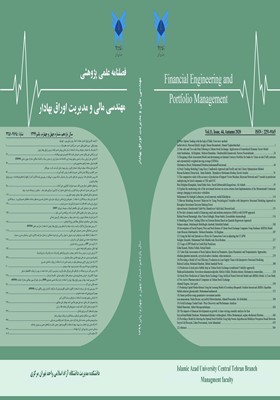پیش بینی بازده بازار سرمایه با استفاده از الگوی یادگیری الگوریتم لورنبرگ مارکوات, گرادیان نزولی و الگوی آریما (ARIMA)
محورهای موضوعی : مهندسی مالیمهدی اشعریون قمی زاده 1 , محمد محمودی 2
1 - گروه حسابداری، واحد دماوند، دانشگاه آزاد اسلامی، دماوند، ایران
2 - گروه حسابداری، واحد فیروزکوه, دانشگاه آزاد اسلامی، فیروزکوه, ایران
کلید واژه: پیش بینی بازده بازار سرمایه, الگوریتم لورنبرگ مارکوات, گرادیان نزولی و الگوی آریما (ARIMA),
چکیده مقاله :
پژوهش حاضر بر اساس ارزیابی الگوی یادگیری الگوریتم لورنبرگ مارکوات، گرادیان نزولی و الگوی آریما به مقایسه و توانایی پیشبینی کنندگی در بازار سرمایه میپردازد. بدین منظور دادههای بازار در سالهای 1394 تا 1397 مورد استفاده قرار گرفت و بیش از 75 درصد از این دادهها تا قبل از سال 1397 به عنوان دادههای آموزشی استفاده شد و دادههای یک سال پایانی نیز به عنوان دادههای آزمایشی مورد استفاده قرار گرفته شده است. نتایج تحقیق نشان دادهاند، شبکههای عصبی مصنوعی ظرفیت بالایی برای پیشبینی قیمت دارند. مقایسه نتایج و عملکرد شبکههای عصبی و الگوی آریما (ARIMA) حاکی از آن است که شبکه عصبی قدرت پیشبینی بالاتری در مقایسه با الگوی خطی آریما (ARIMA) دارد، همچنین مقایسه عملکرد و دقت پیشبینی دو نوع شبکه عصبی با الگوریتم یادگیری لونبرگ مارکوارت و الگوریتم یادگیری گرادیان نزولی نشان داد که استفاده از الگوریتم یادگیری لونبرگ مارکورات توانسته است دقت پیشبینی شبکه عصبی را افزایش داده و خطای آن را کاهش دهد، بنابراین بر پایه پژوهش انجام شده میتوان چنین نتیجه گرفت که الگوریتم یادگیری لونبرگ مارکوارت قدرت پیشبینی شبکه عصبی را بهبود میبخشد.
The present study compares and predicts the predictive ability of the capital market based on the learning pattern of the Levenberg-Marquardt algorithm, the Gradient descent and the ARIMA Algorithm. For this purpose, market data were used in the period from 1394 to 1397, and more than 75% of these data were used as training data prior to 1397, and one year end data were used as data. The results of the evaluation of the research data show that artificial neural networks have a high capacity for price prediction.The results also showed that in both training data series from 1394 to 1396 and experimental of 1397 the comparison of the results and performance of ARIMA neural networks (ARIMA) showed that the neural network had higher predictive power in Comparing with the performance and prediction accuracy of two types of neural networks with the Levenberg-Marquardt learning algorithm and the Gradient descent learning algorithm using the Levenberg-Marquardt learning algorithm has been able to increase the neural network prediction accuracy And reduce its error, so, the results of the present study show, the Levenberg-Marquardt learning algorithm improves the predictive power of the neural network.
_||_
1. Bahrami, Aso and Sadegh Hamekhani. (2015). Using neural network to predict stock price trend, Accounting Management Quarterly, Volume 2, Number 3, pp. 301-322.
2. Rai Reza; Betshekan Mahmoud (2009), stock price forecasting using neural-fuzzy network and its comparison with linear prediction models, PhD thesis, Faculty of Management, University of Tehran.
3. Safa, Mozhgan and Panahyat, Hossein. (2018), "Prioritization of P/E predictors in Tehran Stock Exchange using Harmony Search (HS) meta-heuristic algorithm", Investment Knowledge, Volume 8, Number 29, Spring, pp. 67-82.
4. Falahpour, Saeed and Pourrikandeh Javadali. (2013). Prediction of stock index using wavelet neural networks in Tehran stock exchange. Article 2, period 2, number 4 - serial number 7, winter 2013, pages 15-31
5. Manjemi, Seyed Amir Hossein; Abzari, Mehdi and Raaiti Shawazi, Alireza (2008), stock price prediction in the stock market using fuzzy neural network and genetic algorithms and its comparison with artificial neural network, Quantitative Economics Quarterly. Former Economic Surveys), Volume 6, Number 3.
6. Mehri Namak Avrani Omid and Ehtsham Rathi Reza (2018) "Forecasting bank financial resources using linear (ARIMA) and nonlinear fuzzy artificial neural network models", Financial Engineering and Securities Management Quarterly, Volume 10, Number 41. Winter, page 1-478.
7. Mir Alavi Seyed Hossein and Pourzamani Zahra (2018), "Presentation of a model for predicting stock prices using meta-heuristic methods and neural networks", Financial Engineering and Securities Management Quarterly, Volume and Number: Volume 10, Number 40, Fall , page 1-414.
8. Zamardian Gholamreza, Kashani Tabar Shahrazad and Mana Khaksarian (2018) "Using wavelet neural networks to determine and evaluate the effects of systemic risk on the financial returns of stocks", Financial Engineering and Securities Management Quarterly, Volume and Number: Volume 10, Number 39, Summer, pp. 1-397.
9. Namazi, Mohammad and Mohammad Mahdi Kiamhar, (2016), "Prediction of daily stock returns of companies listed on the Tehran Stock Exchange using artificial neural networks", Financial Research, No. 24, pp. 115-135.
10. Ling-Jing Kao, Chih-ChouChiu, Chi-JieLu, Jung-LiYang(2013). Integration of nonlinear independent component analysis and support vector regression for stock price forecasting, Neurocomputing 99534-542.
11. Liu, L. and Wang, W. (2012). Exchange Rates Forecasting with Least Squares SVM. International Conference on Computer Science and Software Engineering.
12. Lu Xi, Hou Muzhou, Moon Ho Lee, Jun Li, Duan Wei, Han Hai, Yalin Wu(2014). A new constructive neural network method for noise processing and its application on stock market prediction, Applied Soft Computing (15) 57-66.
13. Patel, Jigar. Shah, Sahil. Thakkar, Priyank. Kotecha, K. (2015). Predicting stock market index using fusion of machine learning techniques. Expert Systems with Applications Vo 42, Issue 4, Pp 2162-2172.
14. Ranjeeta Bisoi, P.K. Dash (2014). A hybrid evolutionary dynamic neural network for stock market trend analysis and prediction using unscented Kalman filter, Applied Soft Computing (19) 41–56.
15. Ticknor, Jonathan L, (2013). A Bayesian regularized artificial neural network for stock market forecasting. Expert Systems with Applications Vol 40, Iss 14, , Pp 5501-5506.


